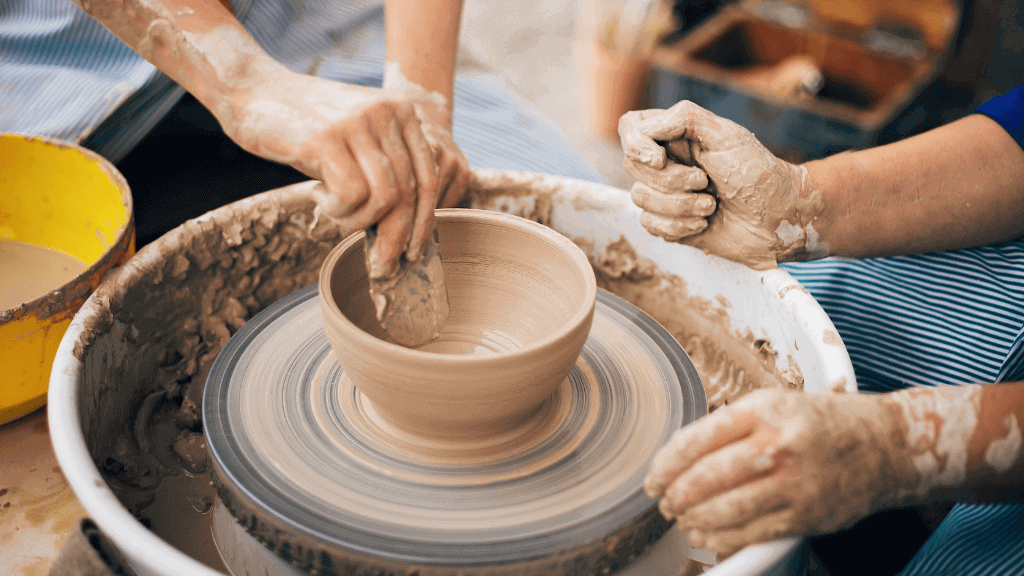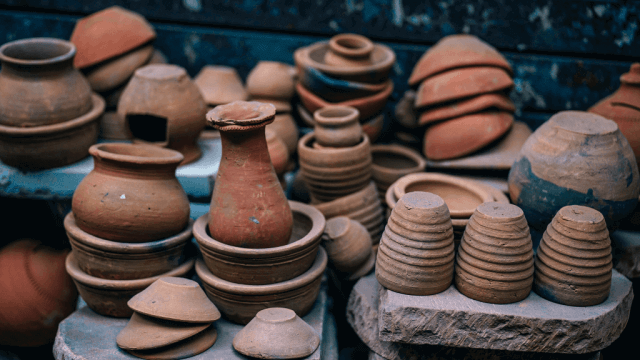Pottery has been an art form for thousands of years, and pottery tools have evolved to make the process easier and more efficient. Pottery tools for throwing are essential for creating beautiful and functional pieces. These tools are designed to help potters shape and mold clay on a pottery wheel, which can be a challenging task for beginners.
When it comes to buying pottery tools for throwing, there are a few things to keep in mind. The type of material used to make the tools is crucial as it can affect the durability and performance of the tool. The size and weight of the tool are also essential factors to consider, as they can impact the precision and ease of use.
After researching and testing multiple pottery tools for throwing, we have identified the best options for both beginners and experienced potters. Our top picks are designed to provide excellent performance and durability while being comfortable to use. Whether you are a professional potter or just starting, our guide will help you find the best pottery tools for throwing to create stunning pieces of art.
Best Pottery Tools for Throwing
For any pottery enthusiast, having the right tools is essential. Whether you are a beginner or a professional, the quality of your pottery tools can make or break your work. There are a variety of pottery tools available in the market, but finding the best ones can be a daunting task. To help you out, here is a list of the best pottery tools for throwing.
Cuptisserie Pottery Throwing Gauge

If you’re looking for a reliable pottery throwing gauge that is easy to use and carry around, the Cuptisserie Pottery Throwing Gauge is a great option.
Pros
- The high-quality stainless steel material and wooden base make it sturdy and durable, ensuring it won’t rust even in humid environments.
- The gauge is easy to install and can be fixed in your work area to prevent it from tilting and damaging your pottery job.
- The adjustable angle, height, and reach length of the throwing arms, along with the rotatable pointer, make it easy to measure the height of your pottery and keep the top flat and smooth.
Cons
- The friction nuts can loosen easily, requiring frequent measuring and adjusting.
- It may get in the way if you’re being creative or making one-of-a-kind pottery.
- The sharp tip can cut into your pots, but this can be remedied by adding an old plastic credit card to the tip.
The Cuptisserie Pottery Throwing Gauge is a practical tool suitable for pottery beginners, families, and enterprises. The smooth surface and edge and smooth sliding make it easy to use and carry around. The gauge is 11″ tall, and the total length of the arm with the pointer is 12.6″, making it fully adjustable to meet your needs.
In conclusion, if you’re looking for a reliable and durable pottery throwing gauge, the Cuptisserie Pottery Throwing Gauge is a great option that won’t disappoint.
DAFENCHI Pottery Throwing Gauge

If you’re looking for a precise and adjustable pottery tool for making repeat forms, the DAFENCHI Pottery Throwing Gauge might be the right choice for you.
Pros
- The adjustable arms allow you to set the height and reach length to your desired position, making it easy to throw to a precise spot.
- Made of natural bamboo and beech, the gauge is sturdy and not easy to deform, even when exposed to water.
- The simple installation process involves fixing the throwing arms and base with screws to complete the assembly.
Cons
- The little things that stick out at the ends of the arms can be difficult to tighten, causing them to droop down.
- The adjustable range of the height might not be enough for some potters, as it only ranges from 2.28 to 11.8 inches.
- While the gauge is useful for making repeat forms, it might not be necessary for potters who don’t make them often.
The DAFENCHI Pottery Throwing Gauge is a necessary tool for production potters who need to make repeat forms with precision. The adjustable arms allow you to set the height and reach length to your desired position, improving accuracy and saving time.
The gauge is made of natural bamboo and beech, which makes it sturdy and not easy to deform, even when exposed to water. The varnished surface also helps to prevent deformation. The simple installation process involves fixing the throwing arms and base with screws to complete the assembly. The base is pre-drilled, and it can be fixed with screws or weights on the workbench to use.
However, the little things that stick out at the ends of the arms can be difficult to tighten, causing them to droop down. The adjustable range of the height might not be enough for some potters, as it only ranges from 2.28 to 11.8 inches. While the gauge is useful for making repeat forms, it might not be necessary for potters who don’t make them often.
Overall, the DAFENCHI Pottery Throwing Gauge is a good choice for potters who need to make repeat forms with precision. Its sturdy build and adjustable arms make it a reliable tool for any production potter.
Kemper Tools for Clay & Pottery – Throwing Stick – TS2

If you’re looking for a tool to shape deep, wheel-thrown pieces with narrow interiors or necks, such as bottles or vases, the Kemper Throwing Stick might be a good option. The tool is made from highly polished hardwood, which gives it a comfortable feel in the hand. The Kemper Throwing Stick comes in two head sizes, both measuring 12-1/2″ long.
Pros
- The curve of the tool fits well into pots, making it easy to shape and smooth the interior of your pottery.
- The highly polished hardwood gives the tool a comfortable feel in the hand, which is important when you’re spending hours at the wheel.
- The Kemper Throwing Stick is a durable tool that can withstand regular use.
Cons
- The tool is asymmetrical, which means it may not work well for left-handed potters or those who throw with their wheel in reverse.
- The Kemper Throwing Stick is relatively expensive compared to other pottery tools on the market.
- Some users have reported that they received only one head size, despite the product description stating that the tool comes with two head sizes.
In summary, if you’re looking for a high-quality throwing stick that will last for years, the Kemper Throwing Stick is a good option. The tool is comfortable to use and can help you shape and smooth the interior of your pottery with ease. However, if you’re a left-handed potter or you throw with your wheel in reverse, you may want to consider a different tool.
Kemper Tools for Clay & Pottery – Throwing Stick – TS1

If you are looking for a versatile tool to shape deep, wheel-thrown pieces with narrow interiors or necks, such as bottles or vases, then Kemper Tools for Clay & Pottery – Throwing Stick – TS1 is a great option.
Pros
- The fine hardwood handle with a satin finish provides a comfortable feel in the hand.
- Made in the USA, this tool is of high quality and durable.
- The two head sizes allow for greater versatility when shaping pottery.
Cons
- The tool may require some practice to use effectively.
- The tool may not be suitable for beginners.
- The tool may not be suitable for larger pottery pieces.
Kemper Tools for Clay & Pottery – Throwing Stick – TS1 is a great tool for those looking to shape deep, wheel-thrown pieces with narrow interiors or necks. The fine hardwood handle with a satin finish provides a comfortable feel in the hand, making it easy to use for prolonged periods. Made in the USA, this tool is of high quality and durable, ensuring it will last for many pottery projects to come. The two head sizes allow for greater versatility when shaping pottery, making it easier to achieve the desired shape and form.
However, the tool may require some practice to use effectively, and may not be suitable for beginners. Additionally, the tool may not be suitable for larger pottery pieces, as the two head sizes may not be sufficient for larger projects. Overall, Kemper Tools for Clay & Pottery – Throwing Stick – TS1 is a great addition to any potter’s toolkit, providing versatility and ease of use for shaping pottery.
C.Rae Designs Ultimate Edger

If you’re looking for a versatile tool that can be used for both throwing and handbuilding ceramics, the C.Rae Designs Ultimate Edger is a great option. With five completely different designs and six perfectly placed edges, this tool is perfect for those who want to experiment with different shapes and textures.
Pros
- The C.Rae Designs Ultimate Edger XL is perfect for creating slightly larger pots.
- The tool has five completely different designs, offering a lot of versatility.
- The tool is made of sturdy 20 gauge stainless steel, ensuring it will last for a long time.
Cons
- The tool might be too aggressive for novices on the wheel.
- It can be difficult to maneuver some of the shapes into place for a uniform trim-job.
- It would be nice to have more visual examples of the final results of each option in the packaging.
The C.Rae Designs Ultimate Edger is a patented tool that is proudly made in the USA. It is precision laser cut from 20 gauge stainless steel, ensuring it is durable and long-lasting. The XL size is perfect for creating slightly larger pots, while the five different designs offer a lot of versatility when throwing or handbuilding ceramics.
While the tool might be too aggressive for novices on the wheel, those with more experience will appreciate its unique design and the different shapes it can create. However, it can be difficult to maneuver some of the shapes into place for a uniform trim-job.
Overall, the C.Rae Designs Ultimate Edger is a great tool for those who want to experiment with different shapes and textures in their ceramics. It would be nice to have more visual examples of the final results of each option in the packaging, but the tool’s versatility and durability make it a great addition to any potter’s toolkit.
Buying Guide
When looking to buy pottery tools for throwing, there are a few key features to keep in mind to ensure you get the best product for your needs.
Material
The material of the tool is an important factor to consider. Pottery tools can be made from a variety of materials, including wood, metal, and plastic. Each material has its own benefits and drawbacks. Wood is lightweight and comfortable to hold, but can warp or crack over time. Metal is durable and long-lasting, but can be heavy and uncomfortable to hold for extended periods. Plastic is lightweight and affordable, but may not be as durable as other materials.
Size and Shape
The size and shape of the tool will also impact its usability. Tools that are too small may be difficult to handle, while tools that are too large may be unwieldy. Additionally, the shape of the tool should be considered. Some tools are designed for specific tasks, such as trimming or shaping. Choosing the right shape can make your pottery throwing experience more efficient and enjoyable.
Ergonomics
Ergonomics refers to the design of the tool to fit comfortably in the hand and reduce strain on the body. Look for tools with comfortable grips and handles that are easy to hold for extended periods. Additionally, consider the weight and balance of the tool. A well-balanced tool will reduce strain on the wrist and forearm.
Durability
Pottery tools can be an investment, so it’s important to choose tools that will last. Look for tools made from high-quality materials and construction. Additionally, consider the manufacturer’s warranty and customer reviews to ensure the tool will hold up over time.
By considering these factors when choosing pottery tools for throwing, you can ensure that you get the best product for your needs.
FAQs about Best Pottery Tools for Throwing
Pottery throwing is a delicate art that requires skill, patience, and the right tools. Here are some frequently asked questions about the best pottery tools for throwing.
What are the essential pottery tools for throwing?
The essential pottery tools for throwing include a pottery wheel, clay, water, a sponge, a needle tool, a rib, and a loop tool. These tools are necessary for shaping, trimming, and smoothing the clay as it spins on the wheel.
What is the best type of pottery wheel for throwing?
The best type of pottery wheel for throwing is an electric wheel with a sturdy base and a powerful motor. The wheel should be able to spin smoothly and consistently at different speeds to accommodate different types of clay and throwing techniques.
What type of clay is best for throwing?
The best type of clay for throwing depends on the potter’s preference and the type of pottery being made. Some popular types of clay for throwing include stoneware, porcelain, and earthenware. Each type of clay has its own unique properties and characteristics that affect its workability, texture, and firing temperature.
What are the different types of rib tools used for pottery throwing?
There are several types of rib tools used for pottery throwing, including metal ribs, rubber ribs, and wooden ribs. Metal ribs are durable and provide a smooth finish, while rubber ribs are flexible and gentle on the clay. Wooden ribs are versatile and can be used for shaping and smoothing the clay.
What is the purpose of a needle tool in pottery throwing?
A needle tool is used to trim excess clay, create texture, and carve designs into the clay. It is a versatile tool that can be used for both functional and decorative purposes.
How should pottery tools be cleaned and maintained?
Pottery tools should be cleaned and maintained regularly to ensure their longevity and effectiveness. Metal tools should be wiped down with a cloth and oiled to prevent rust. Wooden tools should be sanded and oiled to prevent cracking and splitting. Rubber tools should be washed with soap and water and allowed to dry completely before use.
Overall, the right pottery tools can make all the difference in the success of a pottery project. By investing in high-quality tools and maintaining them properly, potters can achieve beautiful and functional pieces that showcase their skill and creativity.











